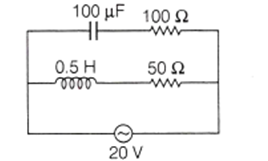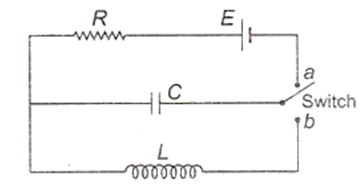 Multiple Choice Questions
Multiple Choice QuestionsIn the given circuit, the AC source has ω = 100 rad/s, considering the inductor and capacitor to be ideal,

the current through the circuit is 0.4 A
the current through the circuit is 0.3 A
the voltage across 100 Ω resistor is 10 V
the voltage across 50 Ω resistor is 10 V
The impedence of a circuit, when a resistance R and an inductor of inductance L are connected in series in an AC circuit of frequency f, is
In a series LCR circuit, resistance R = 10 Ω and the impedance Z = 10 Ω. The phase difference between the current and the voltage is
0°
30°
45°
60°
A circuit consists of an inductance of 0.5 mH and a capacitor of 20 µF. The frequency of the LC oscillations is approximately
400 Hz
88 Hz
1600 Hz
2400 Hz
The maximum value of AC voltage in a circuit is 707 V. Its rms value is
70.7 V
100 V
500 V
707 V
If an alternating voltage is represented as E = 141 sin (628 t), then the rms value of the voltage and the frequency are respectively
141 V, 628 Hz
100 V, 50 Hz
100 V, 100 Hz
141 V, 100 Hz
A step-down transformer is used on a 1000 V line to deliver 20 A at 120 V at the secondary coil. If the efficiency of the transformer is 80%, the current drawn from the line is
3 A
30 A
0.3 A
2.4 A
An alternating current of rms value 10 A is passed through a 12 Ω resistor. The maximum potential difference across the resistor is
20 V
90 V
169.68 V
None of these
In the circuit shown below, the switch is kept in position a for a long time and is then thrown to position b. The amplitude of the resulting oscillating current is given by

E / R
infinity
